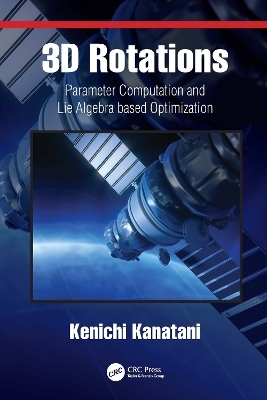
3D Rotations
Chapman & Hall/CRC (Verlag)
978-0-367-49690-6 (ISBN)
Mathematically, the set of all 3D rotations forms a group denoted by SO(3). Exploiting this group property, we obtain an optimal solution analytical or numerically, depending on the problem. Our numerical scheme, which we call the "Lie algebra method," is based on the Lie group structure of SO(3).
This book also proposes computing projects for readers who want to code the theories presented in this book, describing necessary 3D simulation setting as well as providing real GPS 3D measurement data. To help readers not very familiar with abstract mathematics, a brief overview of quaternion algebra, matrix analysis, Lie groups, and Lie algebras is provided as Appendix at the end of the volume.
Kenichi Kanatani received his B.E., M.S., and Ph.D. in applied mathematics from the University of Tokyo in 1972, 1974, and 1979, respectively. After serving as Professor of computer science at Gunma University, Gunma, Japan, and Okayama University, Okayama, Japan, he retired in 2013 and is now Professor Emeritus of Okayama University.He was a visiting researcher at the University of Maryland, U.S. (1985–1986, 1988–1989, 1992), the University of Copenhagen, Denmark (1988), the University of Oxford,U.K. (1991), INRIA at Rhone Alpes, France (1988), ETH, Switzerland (2013), the Uni-versity of Paris-Est, France (2014), Link ̈oping University, Sweden (2015), and NationalTaiwan Normal University (2019).He is the author of K. Kanatani,Group-Theoretical Methods in Image Understanding(Springer, 1990), K. Kanatani,Geometric Computation for Machine Vision(Oxford Uni-versity Press, 1993), K. Kanatani,Statistical Optimization for Geometric Computation:Theory and Practice(Elsevier, 1996; reprinted Dover, 2005), K. Kanatani,Understand-ing Geometric Algebra: Hamilton, Grassmann, and Clifford for Computer Vision andGraphics(CRC Press, 2015), K. Kanatani, Y. Sugaya, Y. Kanazawa,Ellipse Fitting forComputer Vision: Implementation and Applications(Morgan-Claypool, 2016), and K.Kanatani, Y. Sugaya, Y. Kanazawa,Guide to 3D Vision Computation: Geometric Anal-ysis and Implementation(Springer, 2016).He received many awards including the best paper awards from IPSJ (1987) , IEICE(2005), and PSIVT (2009). He is a Fellow of IEEE, IAPR, and IEICE.1
Chapter 1
Introduction
1.1 3D ROTATIONS
1.2 ESTIMATION OF ROTATION
1.3 DERIVATIVE-BASED OPTIMIZATION
1.4 RELIABILITY EVALUATION OF ROTATION COMPUTATION
1.5 COMPUTING PROJECTS
1.6 RELATED TOPICS OF MATHEMATICS
Chapter 2 ■ Geometry of Rotation
2.1 3D ROTATION
2.2 ORTHOGONAL MATRICES AND ROTATION MATRICES
2.3 EULER’S THEOREM
2.4 AXIAL ROTATIONS
2.5 SUPPLEMENTAL NOTE
2.6 EXERCISES
Chapter 3 ■ Parameters of Rotation
3.1 ROLL, PITCH, YAW
3.2 COORDINATE SYSTEM ROTATION 15
3.3 EULER ANGLES
3.4 RODRIGUES FORMULA
3.5 QUATERNION REPRESENTATION 21
3.6 SUPPLEMENTAL NOTES
3.7 EXERCISES
Chapter 4 ■ Estimation of Rotation I: Isotropic Noise
4.1 ESTIMATING ROTATION
4.2 LEAST SQUARES AND MAXIMUM LIKELIHOOD
4.3 SOLUTION BY SINGULAR VALUE DECOMPOSITION
4.4 SOLUTION BY QUATERNION REPRESENTATION
4.5 OPTIMAL CORRECTION OF ROTATION
4.6 SUPPLEMENTAL NOTE
4.7 EXERCISES
Chapter 5 ■ Estimation of Rotation II: Anisotropic Noise
5.1 ANISOTROPIC GAUSSIAN DISTRIBUTIONS
5.2 ROTATION ESTIMATION BY MAXIMUM LIKELIHOOD
5.3 ROTATION ESTIMATION BY QUATERNION REPRESENTATION
5.4 OPTIMIZATION BY FNS
5.5 METHOD OF HOMOGENEOUS CONSTRAINTS
5.6 SUPPLEMENTAL NOTE
5.7 EXERCISES
Chapter 6 ■ Derivative-based Optimization: Lie Algebra Method
6.1 DERIVATIVE-BASED OPTIMIZATION
6.2 SMALL ROTATIONS AND ANGULAR VELOCITY
6.3 EXPONENTIAL EXPRESSION OF ROTATION
6.4 LIE ALGEBRA OF INFINITESIMAL ROTATIONS
6.5 OPTIMIZATION OF ROTATION
6.6 ROTATION ESTIMATION BY MAXIMUM LIKELIHOOD
6.7 FUNDAMENTAL MATRIX COMPUTATION
6.8 BUNDLE ADJUSTMENT
6.9 SUPPLEMENTAL NOTES
6.10 EXERCISES
Chapter 7 ■ Reliability of Rotation Computation
7.1 ERROR EVALUATION FOR ROTATION
7.2 ACCURACY OF MAXIMUM LIKELIHOOD
7.3 THEORETICAL ACCURACY BOUND
7.4 KCR LOWER BOUND
7.5 SUPPLEMENTAL NOTES
7.6 EXERCISES
Chapter 8 ■ Computing Projects
8.1 STEREO VISION EXPERIMENT
8.2 OPTIMAL CORRECTION OF STEREO IMAGES
8.3 TRIANGULATION OF STEREO IMAGES
8.4 COVARIANCE EVALUATION OF STEREO RECONSTRUCTION
8.5 LAND MOVEMENT COMPUTATION USING REAL GPS DATA
8.6 SUPPLEMENTAL NOTES
8.7 EXERCISES
Appendix A ■ Hamilton’s Quaternion Algebra
A.1 QUATERNIONS
A.2 QUATERNION ALGEBRA
A.3 CONJUGATE, NORM, AND INVERSE
A.4 QUATERNION REPRESENTATION OF ROTATIONS
A.5 COMPOSITION OF ROTATIONS
A.6 TOPOLOGY OF ROTATIONS
A.7 INFINITESIMAL ROTATIONS
A.8 REPRESENTATION OF GROUP OF ROTATIONS
A.9 STEREOGRAPHIC PROJECTION
Appendix B ■ Topics of Linear Algebra
B.1 LINEAR MAPPING AND BASIS
B.2 PROJECTION MATRICES
B.3 PROJECTION ONTO A LINE AND A PLANE
B.4 EIGENVALUES AND SPECTRAL DECOMPOSITION
B.5 MATRIX REPRESENTATION OF SPECTRAL DECOMPOSITION
B.6 SINGULAR VALUES AND SINGULAR DECOMPOSITION
B.7 COLUMN AND ROW DOMAINS
Appendix C ■ Lie Groups and Lie Algebras
C.1 GROUPS
C.2 MAPPINGS AND GROUPS OF TRANSFORMATION
C.3 TOPOLOGY
C.4 MAPPINGS OF TOPOLOGICAL SPACES
C.5 MANIFOLDS
C.6 LIE GROUPS
C.7 LIE ALGEBRAS
C.8 LIE ALGEBRAS OF LIE GROUPS
Answers
Bibliography
Index
| Erscheinungsdatum | 08.03.2022 |
|---|---|
| Zusatzinfo | 2 Tables, black and white; 25 Illustrations, black and white |
| Sprache | englisch |
| Maße | 178 x 254 mm |
| Gewicht | 317 g |
| Themenwelt | Informatik ► Grafik / Design ► Digitale Bildverarbeitung |
| Informatik ► Software Entwicklung ► Spieleprogrammierung | |
| Mathematik / Informatik ► Informatik ► Theorie / Studium | |
| ISBN-10 | 0-367-49690-9 / 0367496909 |
| ISBN-13 | 978-0-367-49690-6 / 9780367496906 |
| Zustand | Neuware |
| Informationen gemäß Produktsicherheitsverordnung (GPSR) | |
| Haben Sie eine Frage zum Produkt? |
aus dem Bereich


